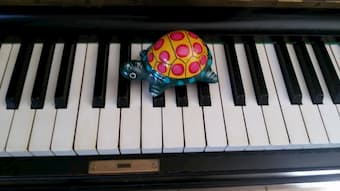Ever watched a piano virtuoso flying around the keyboard at breakneck speed, or an ensemble ripping through John Adams’ frantic Chamber Symphony? One of the things that these have in common is the preparation needed to reach such dazzling speeds: the idea of slow practice.

© Pianoways
Although it’s often one of the most frustrating things to do as a musician, it’s also one of the most important. Learning a new piece is an onslaught of new information for our bodies and brains, especially if there are fast notes involved. Practising things slowly gives us chance to strip away some of the confusion in order to focus on the technical side of things – but it is not without its pitfalls. Read on for my top tips on how to get the most from slow practice.
1. Stay Present
Perhaps the most important thing to do when practising something slowly is to not switch off. Slow the music right down to a speed at which you can play it, and then stay curious about how you progress. If you can play the music slowly but aren’t registering how it’s going into your body, you’re missing a trick: staying present when practising things slowly will help you to better retain the information and make faster progress. With this said, however, it’s also important to remember to…
2. Be Patient
Practising something slowly can be frustrating. We hear and see inspiring performances from people, presenting the polished final version of something they’ve spent hours and hours perfecting, and in that moment we forget about the preparation they undertook to achieve that. No-one escapes slow practice, not even the biggest stars – and chances are, the most successful people have had the patience and discipline to sit through hours and hours of slow practice, only increasing the speed incrementally when they are confident to do so. With slow practice, patience really is a virtue; give yourself time and patience and you shall reap the rewards.

© Classy
3. Ride the Wave of Interest
It’s only natural that after a while practising something slowly out of context will begin to seem… dull. Uninteresting. Pointless. You’re at that moment where the initial passion for the piece has waned, yet you’re still some way from the finish line. Don’t worry – everyone goes through this. Accept that there will be days where you are less motivated than others. Enjoy the days where the motivation is running high, and be kind to yourself when it isn’t. Take a moment: remember what inspired you to start learning the piece in the first place. Perhaps listen to a recording of the piece to rekindle your passion and remind yourself of why you started to learn it in the first place. And most importantly: remember that in committing to following through and learning the piece, the most difficult bit of the work has been done!
4. Keep in touch with the music
A sort of amalgamation of all the above, the most important thing is to remember why you’re ultimately doing the slow practice in the first place. Remember to zoom out and take stock of where you are in the learning of the piece. Don’t forget that the reason we do slow practice isn’t to be able to rattle off a dry passage of fast notes: it’s to assimilate something into our technique so our playing can focus on expression and intent, rather than hitting all the right notes in the right order. Mix it up: alternate slow practice of technically difficult passages with more familiar pieces so you stay fresh and engaged. And remember: if you stay present and patient, slow practice will be one of your most powerful tools as a musician.
For more of the best in classical music, sign up to our E-Newsletter



